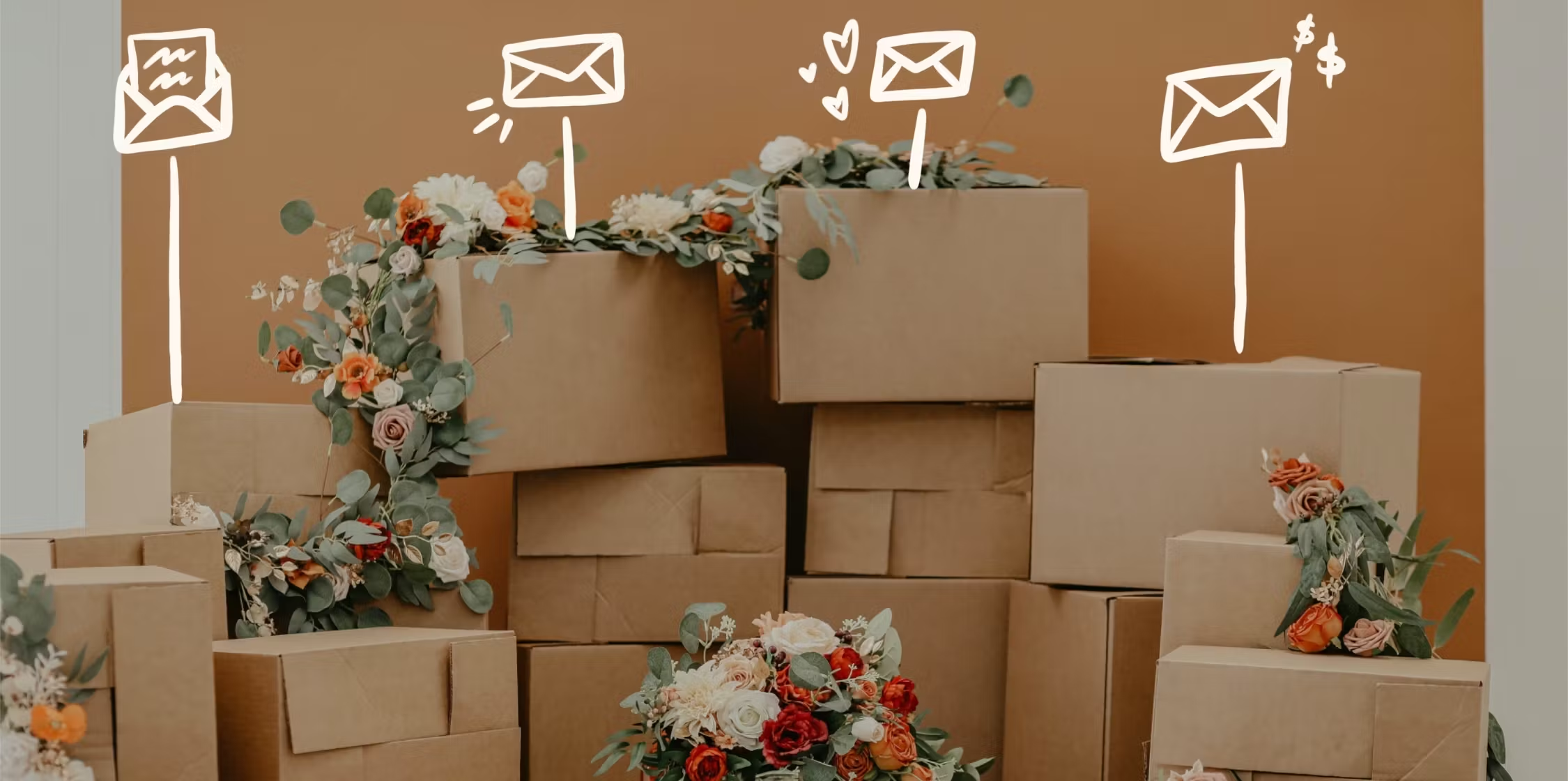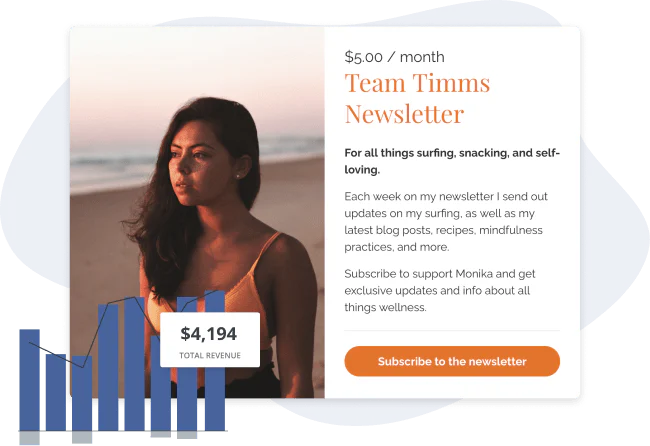In this Article
Releasing a new product to your audience is one of the most vulnerable things you can do as a creator.
The best way to counteract that sense of uncertainty is to build systems and templates that keep you on track—no matter how challenged or unmotivated you might feel during your product launch.
Is one of your goals for the next quarter or year to maximize the impact your emails make when you’re launching? If so, you’ll love the tips and examples in this guide—and the launch email templates you can add to your account immediately.
What is a product launch email?
A product launch email is a message you send to your audience to tell them a product is available for sale.
Creators use a product launch email or sequences when they have a new digital product, ebook, paid subscription, coaching program, or any other type of content.
Creators should use product launch emails to:
- Customize each subscriber’s journey: Personalized email drip campaigns make promotion hyper-relevant for subscribers, like pitching a course automatically after they download a related lead magnet. Since you set up and reuse product launch emails, you can customize sales pitches for multiple audiences without manually tracking and sending messages.
- Build an evergreen launch process: Whether you prefer running live launches (with open and closed carts) or offering evergreen products, emails mean you can rinse and repeat your strategy with the next launches, including new products. Once you build email sequences and automations that run everything on autopilot, launches can become as simple as tweaking a few details and switching a toggle.
- Integrate with all the systems you use: Websites, webinars, quizzes, memberships, giveaways—whatever systems and workflows are already part of your creator tech stack—slot right into email marketing. Product launch emails are a bridge between your email list and your products.
The 6 different types of product launch emails
Product launch emails are more like a marketing category than a rigid format you have to follow. Here are the different types of product launch emails you use to build anticipation, increase subscriber engagement, and maximize sales.
- Product teaser messages hint at upcoming releases to build excitement
- Pre-sales and pre-orders let subscribers note their interest or buy a product before its release day (usually at a discount)
- Re-engagement emails aim to boost open and click-through rates before a launch so as many people see your product launch as possible
- Launch day messages tell your subscribers that sales are open to everyone
- Upsell emails promote an additional paid product to a customer who bought something related
- Downsell emails present a different, typically cheaper, product to subscribers who don’t buy your initial promotion
How to create and write a great product launch email (+ top examples)
You want your product launch email to be effective without feeling overly salesy, remind subscribers enough without overwhelming them, and be personalized without hand-writing messages.
It feels like a tall order, but planning and preparation make it easier to create a great product launch email.
Let’s explore the steps:
- Write a great email subject line
- Use recognizable branding
- Personalize the launch email
- Write about the product and benefits
- Include product visuals
- Add a CTA
- Consider a countdown timer
- Add a sign off
1. Focus on your product launch email subject line
An eye-catching and curiosity-inspiring email subject line will increase your email open rate so more people actually see what you’re offering. Remember to be truthful in your subject line, though—subscribers won’t appreciate it if you use fantastical claims or clickbait only to change the tune of your message.
Subject line templates for product launch emails
- Available now: [product name]
- [Product] is open for registration today!
- ⏰ It’s Almost Time! – inspiration via Harlem Fashion Row
- I can’t wait for you to see this
- 🎉 YOUR EARLY ACCESS IS HERE: Meet the [Product]! – inspiration via Lavendaire
- The wait is over, access [product] now!
- Launching today! [Product name]
- I’ve been working hard on this for you…
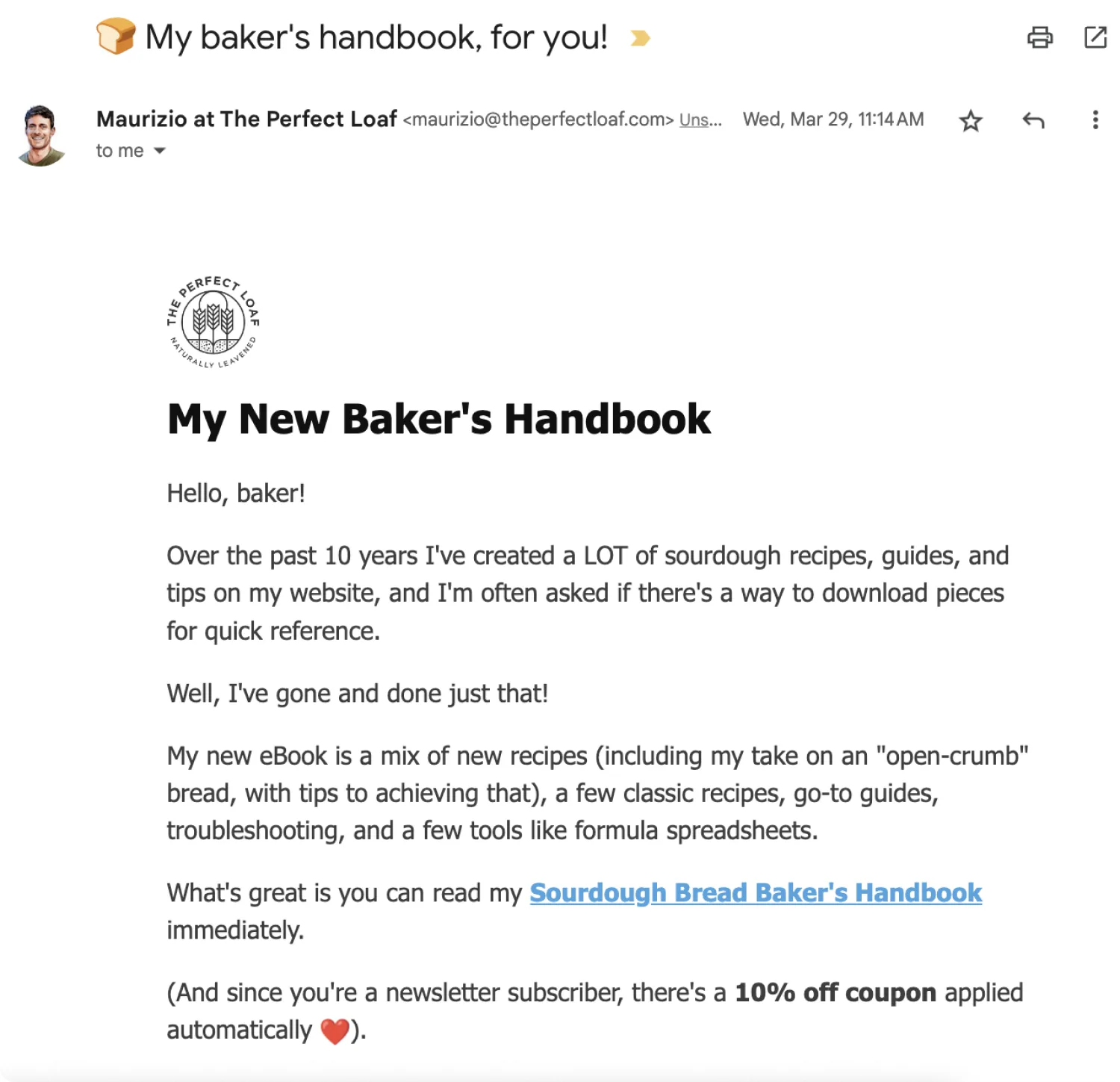
Maurizio Leo uses emojis to stand out in the inbox
Why Maurizio Leo’s product launch email works
- The emojis stand out in a text-heavy inbox
- It mentions the product is ‘for you,’ which feels personal
- The body copy mentions Maurizio’s experience
2. Use recognizable branding
The goal of recognizable branding is to give subscribers comfort and familiarity. You’ve worked hard on making your face, branding, and style familiar, and you’ll want subscribers to perceive your emails similarly.
“Why is this person emailing me? Who is this?” The goal is to make sure this doesn’t cross your subscribers’ minds once your launch emails go out.
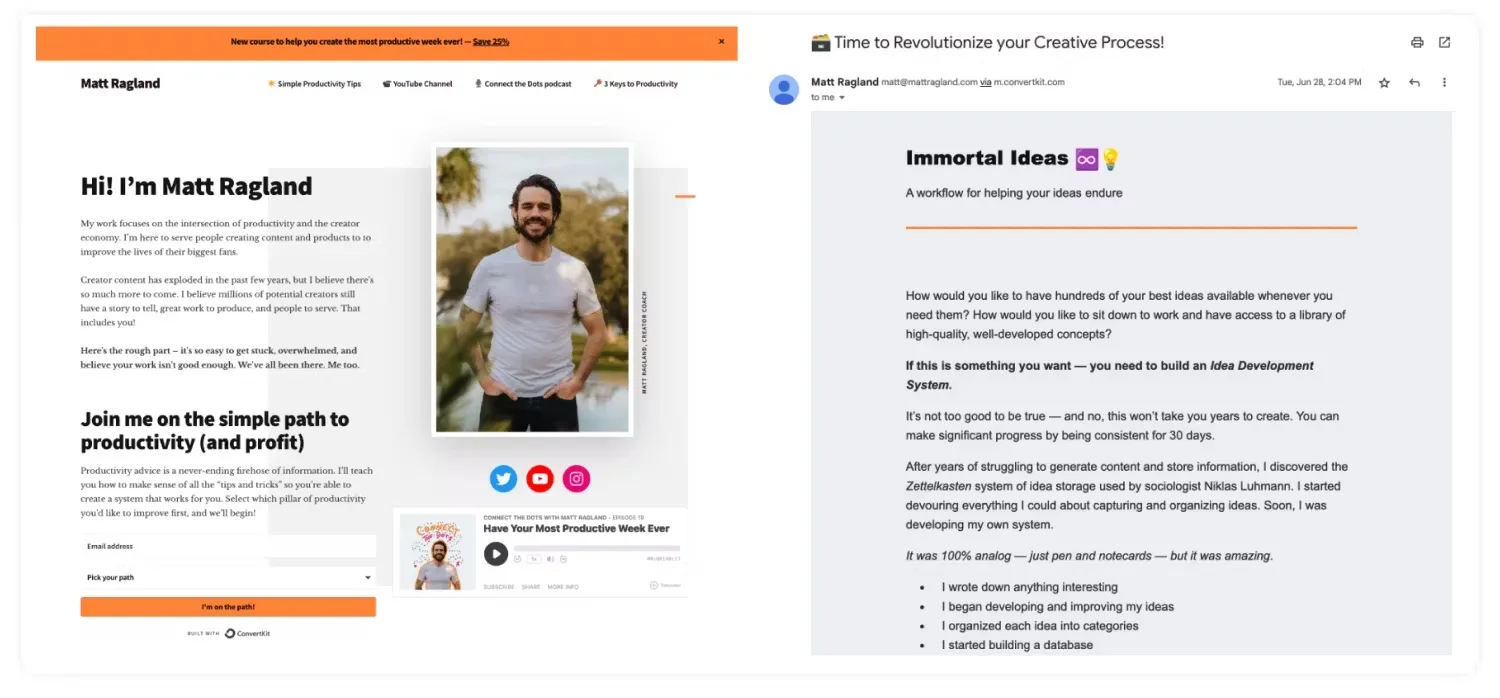
Matt Ragland’s website and emails have consistent branding
Why Matt Ragland’s product launch email works
- The gray and orange color scheme carries through from website to email
- It has repeating shapes and design elements
- It uses a consistent font family
3. Personalize the email introduction and content
Personalization is another part of making your subscribers feel like they’re in the right place when they open your launch email.
Of course, one part of that is addressing them by their name. That’s table stakes in pretty much any email marketing platform. But beyond using your subscribers’ names, you can also personalize email content based on:
- The lead magnet they signed up for in the past
- Product(s) they’ve already purchased from you
- Specific topics they’ve clicked on and shown interest in
The more you understand the interests and challenges of each subscriber, the better your launch emails will be.

Lavendaire’s launch email connects with the audience’s goals
Why Lavendaire’s product launch email works
- The copy connects with the audience’s perspectives and goals
- The launch email promoted a free webinar on a related topic
- It mentions product details and benefits
4. Write an in-depth product description and highlight the benefits
Explaining the details and value of your product is essential in your launch email. You can think of the heart of your launch email as a condensed version of your product landing page because you’ll include:
- The issue your product is solving and the transformation it creates
- The type of person who will benefit from this product the most
- Format details, like live delivery, on-demand videos, or written lessons
- Content that supports taking action, like exercises, worksheets, and cheat sheets
- Timeline specifics, like how long it will take to go through the materials, implement them, see results, and more
- Communication and support, like live calls, office hours, and chat
In this space, you’re showing your subscribers they’re the type of person you made this product for—and the logistics of their journey to seeing results
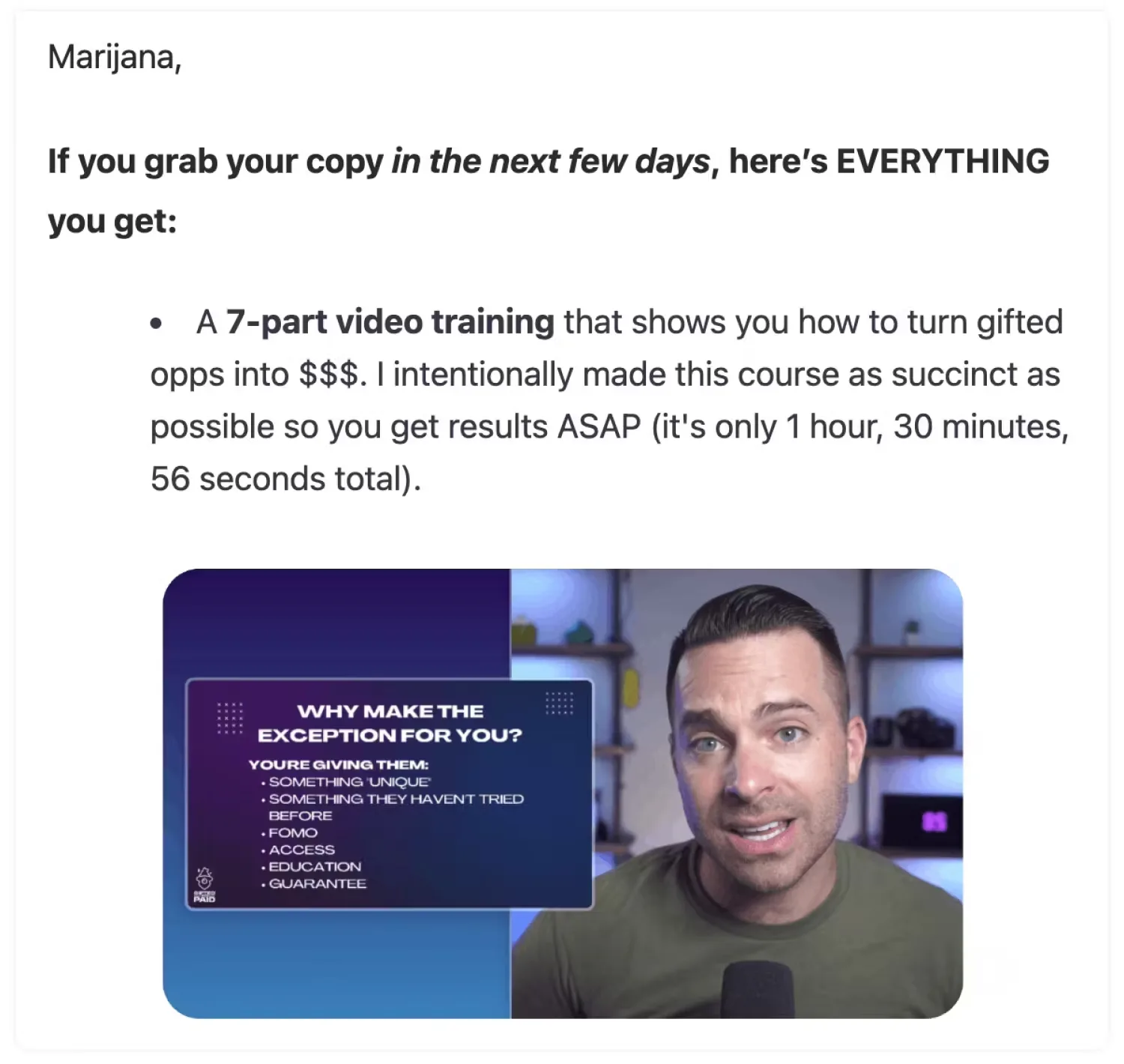
Justin Moore used email to have a $40,000 course launch
Why Justin Moore’s product launch email works
- It explains the content format
- It mentions how long the course takes
- It explains why subscribers should care about it
5. Include visuals that showcase your product
People love seeing what their experience will look like once they buy a product like an online course or an ebook. It’s what helps them picture themselves going through it and seeing results.
Of course, you’ll want to make sure you’re not giving anything away for free that you don’t want to. Use this as an opportunity to showcase how thorough, organized, and valuable your product is—and help your future customers see themselves using it.
If you’re sending emails with Kit, you can embed individual images or image galleries right into your product launch emails with just a few clicks.
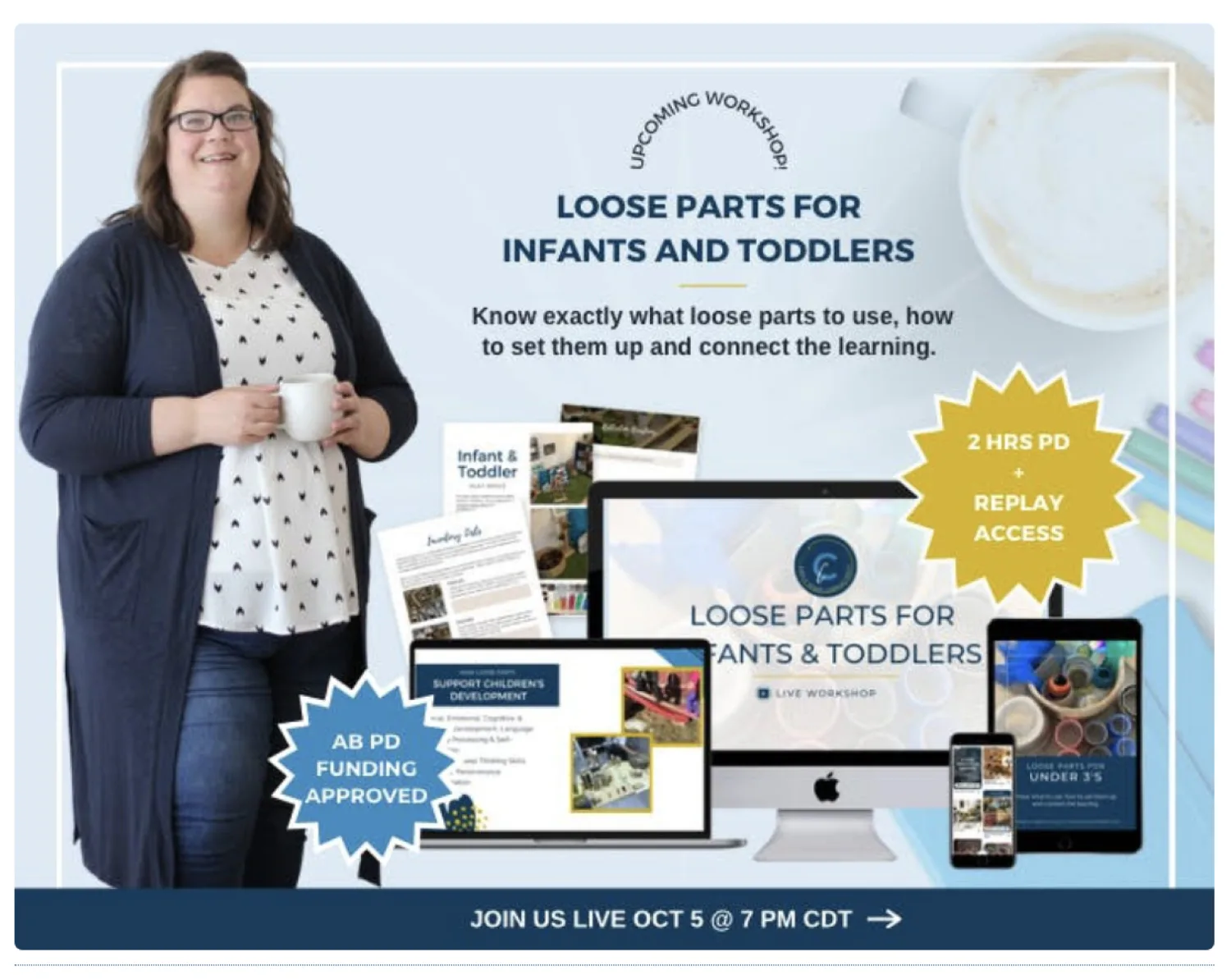
Cultivating Confidence gives subscribers a sneak peek at content
Why Veronica’s product launch email works
- It visually indicates that it’s a virtual and digital offer
- The graphic has a few slides, resources, and images for reference
- It includes details like content length and benefits
6. Add an unmissable call-to-action
When you send product launch emails, it’s best if all of the links you add lead to the page where subscribers learn more about your product and complete their purchase. You can sprinkle that link throughout your email in places where it makes sense.
On top of that, use a large, unmissable call-to-action (CTA) section. If your email is on the longer side, you can even include it twice. Consider different call-to-action examples to inspire your own.
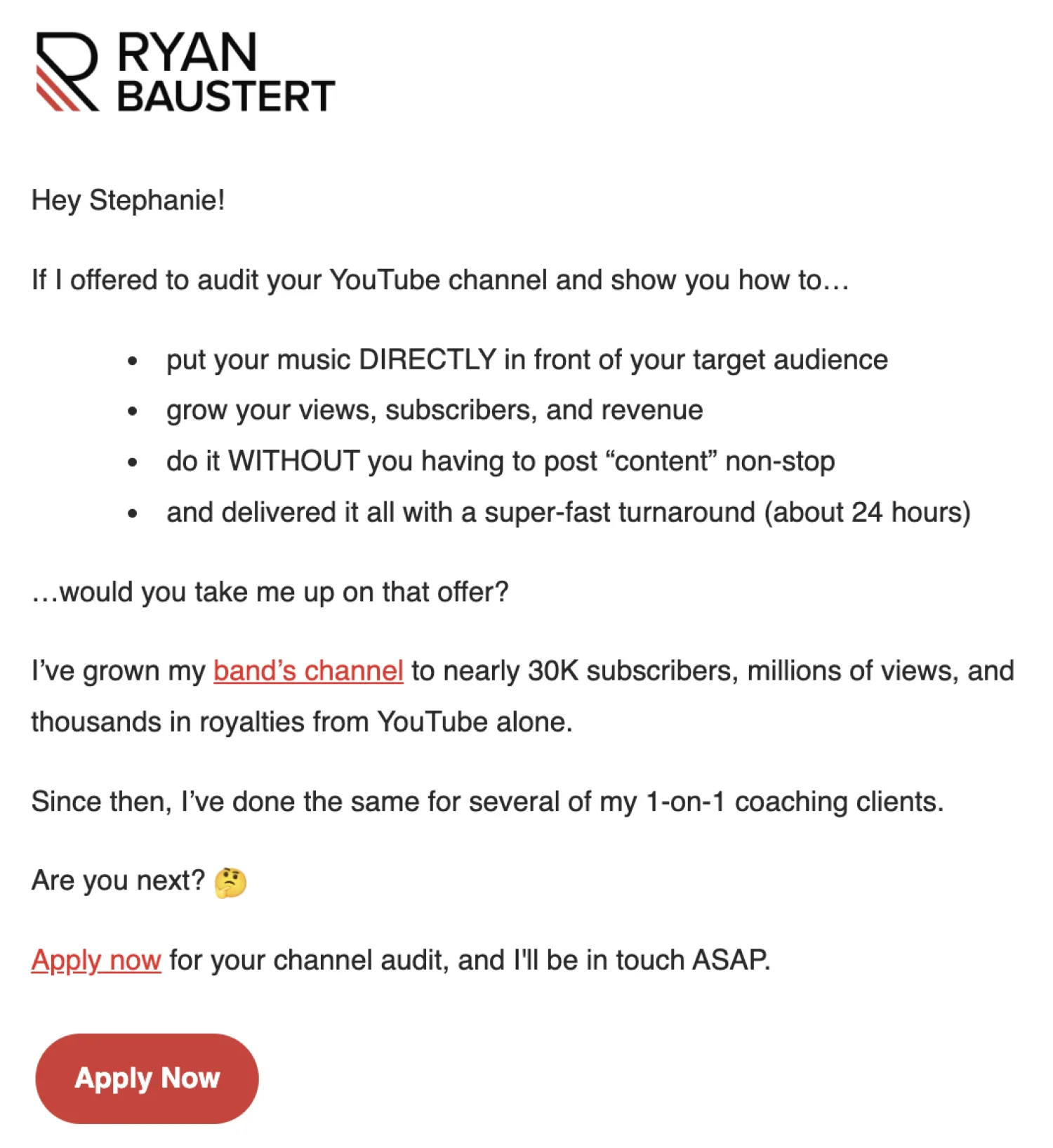
Ryan Baustert and his band, Throw the Fight, use email automations to promote products
Why Ryan Baustert’s product launch email works
- The bold CTA color stands out and matches branding
- There are easy-to-scan bullet points with the benefits
- Ryan mentions results to add credibility
7. Consider using a countdown timer
A countdown timer doesn’t need lots of explaining: it makes it easy to show your subscribers that there’s an end to what you’re offering.
Even if your product is evergreen, inject some scarcity by offering limited-time bonuses or discounts. Once the time is up, the offer is gone—and the countdown timer is the perfect way to show this to your subscribers. It’s a fantastic addition to launch emails and last-chance emails.
Countdown timers are another easy element to add to your emails with Kit.
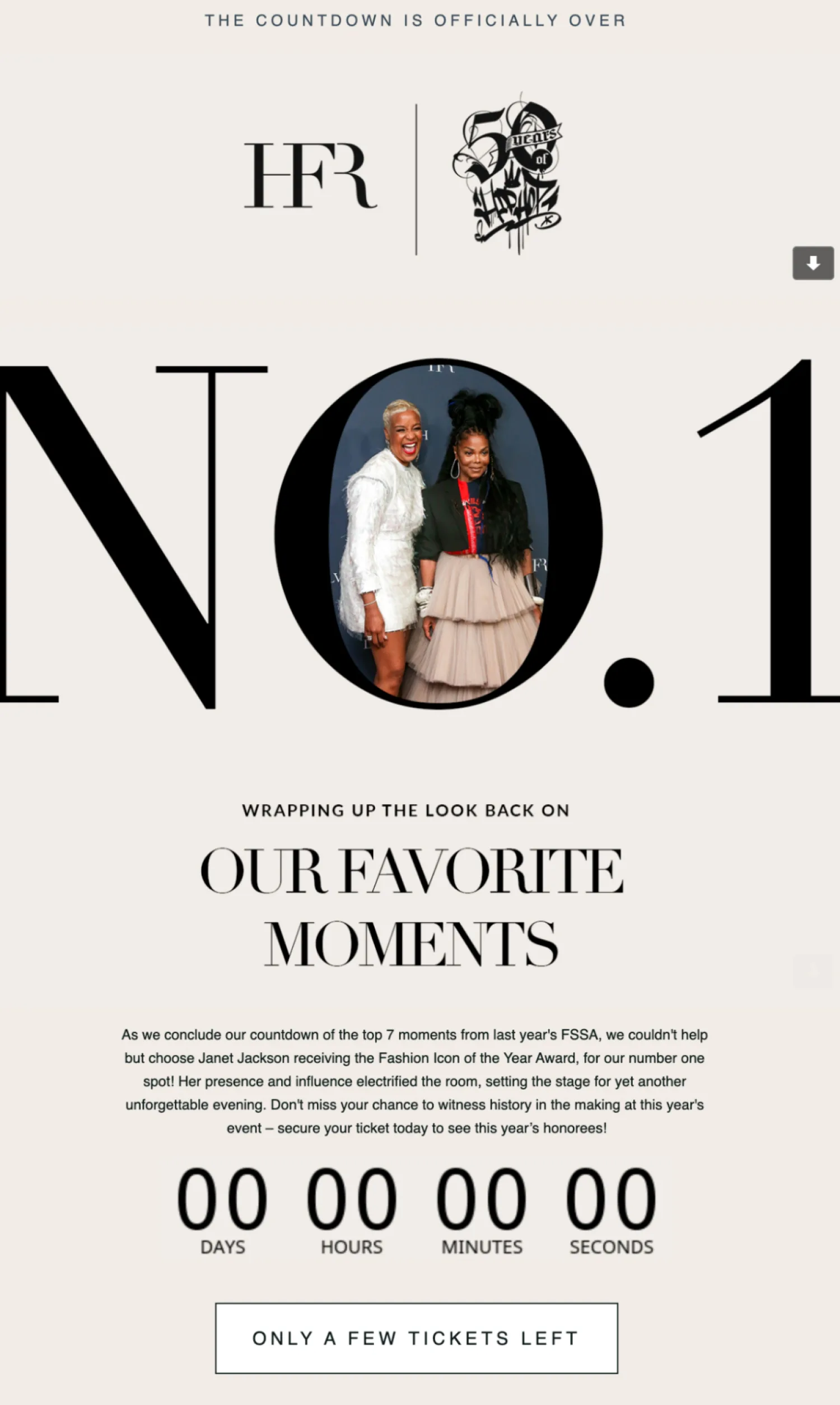
Brandice Daniel boosts urgency with a countdown timer and CTA copy
Why Brandice Daniel’s product launch email works
- The countdown timer raises the stakes and informs readers how much longer they have
- The CTA copy also adds scarcity
- It has consistent branding throughout the email
8. Sign off with a custom signature
There’s a chance your subscriber reaches the end of your email and pauses to think about your offer before taking action. This is an opportunity to tackle their potential insecurities and objections by adding impactful elements, like social proof and relevant links, to your signature.
You could also use this section to point to your signup page (again), case studies, results, examples, and frequently asked questions (and answers) about your product to add another layer of reassurance for those on the fence about purchasing.
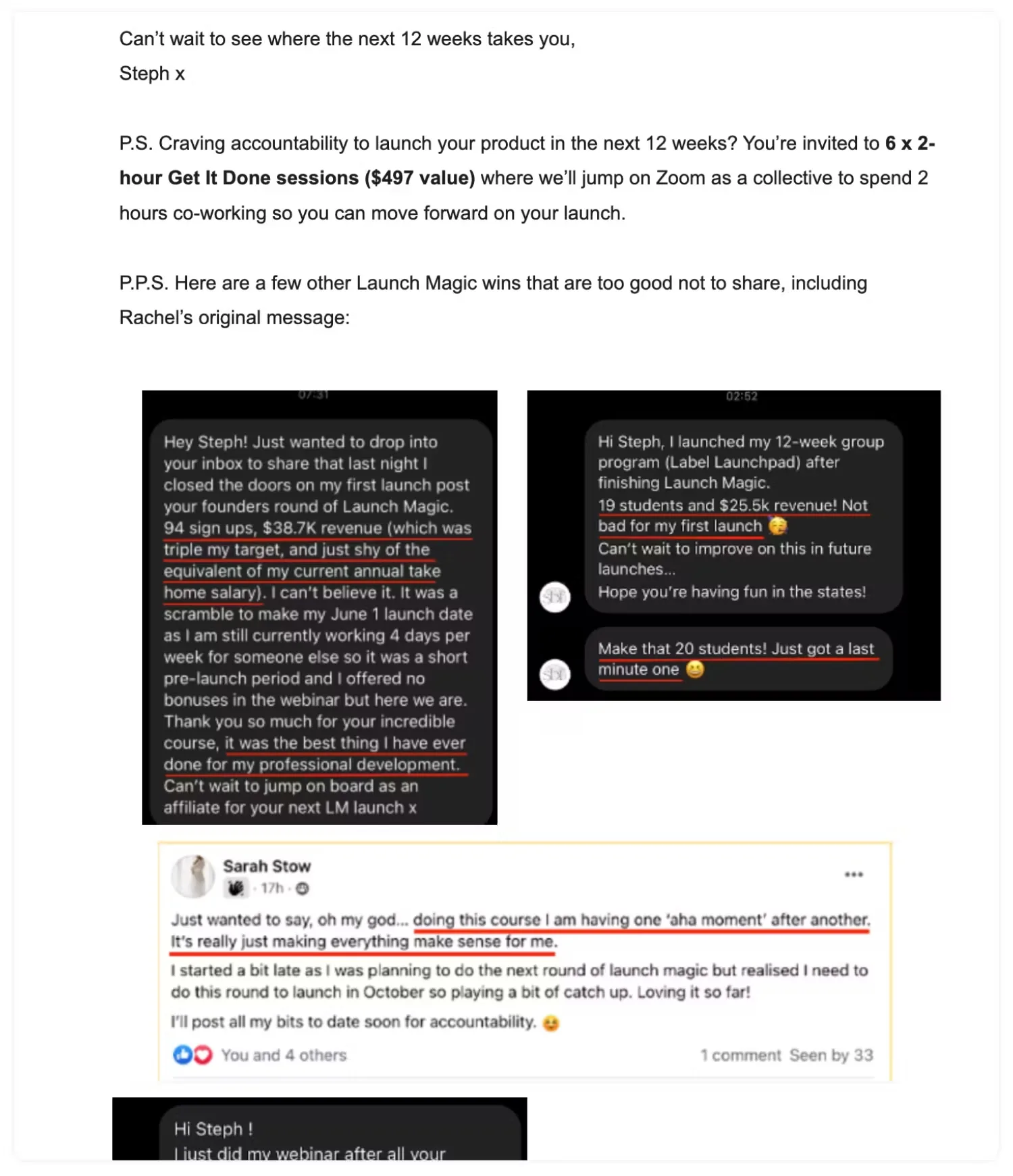
Steph Taylor’s launch email signature uses social proof to reassure potential customers
Why Steph Taylor’s product launch email works
- The screenshots of customer testimonials are social proof
- It addresses potential concerns
- The testimonials feel low-pressure since they aren’t the focus of the email
Plan and map out your product launch email sequence
A product launch email sequence is the messages you send before, during, and after your launch day to promote a product. Drop hints about your launch a month or two before release day and continue with reminders or downsells until two weeks after your product launch.
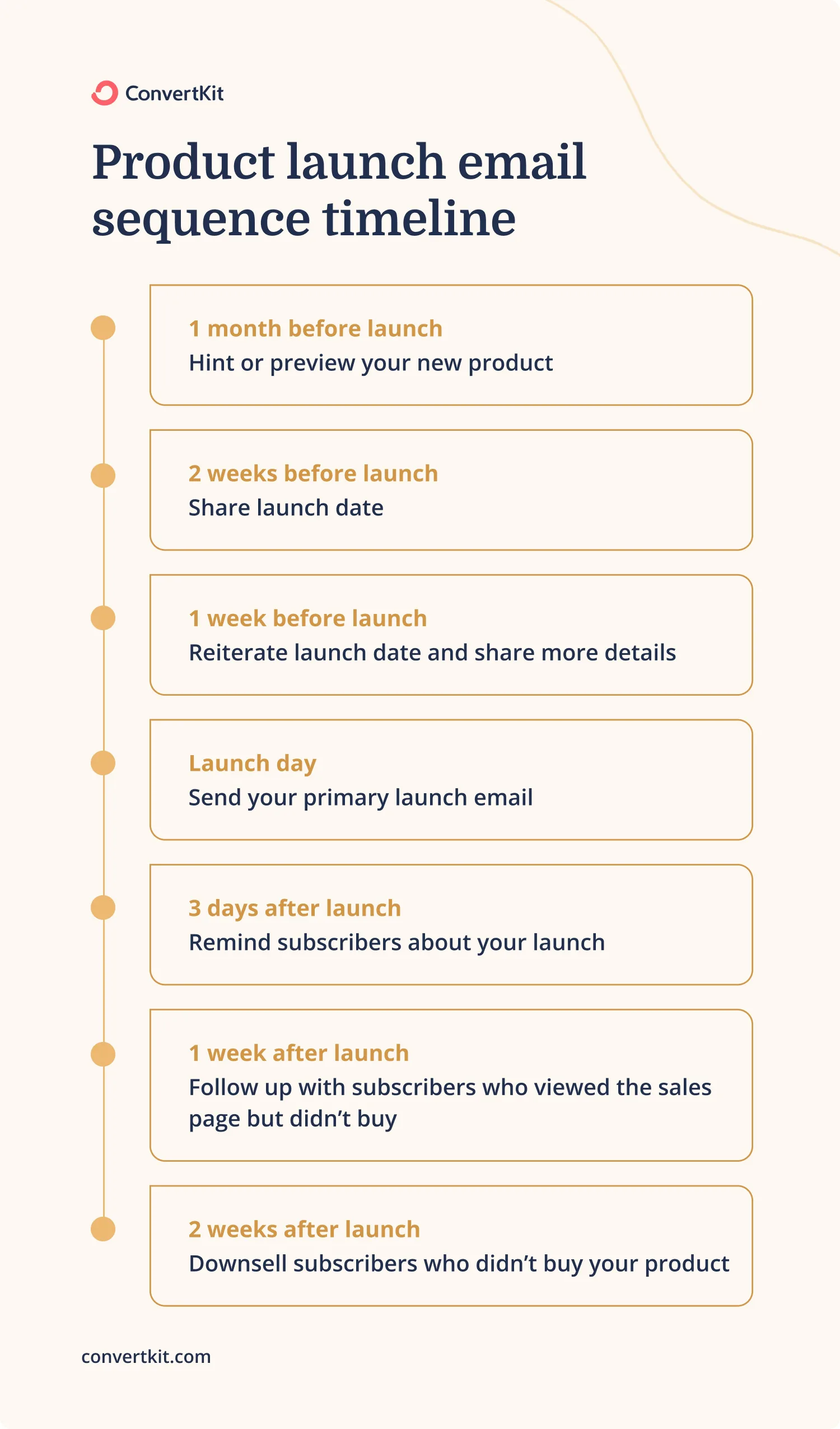
You can make your launch emails as complex and personalized as you want, but let’s review a simple four-part email sequence.
Email #1: Announcement or pre-order
The first email in your product launch sequence kicks off the excitement—you’re telling your subscribers about the new product you’re launching soon!
Now, the specifics of the email, like its call-to-action (CTA) and desired outcome, will depend on the launch strategy you’ve chosen. Here are some options:
- Announce product: Let your audience know that a launch is coming up and that they can be the first to hear it’s available by signing up on your coming soon landing page.
- Accept pre-orders: Give subscribers or certain segments a chance to buy the product early— use discounts to make it worth the upfront payment and wait.
- Offer a free resource: Use a lead magnet, like a webinar, to provide value upfront and then pitch your product at the end.
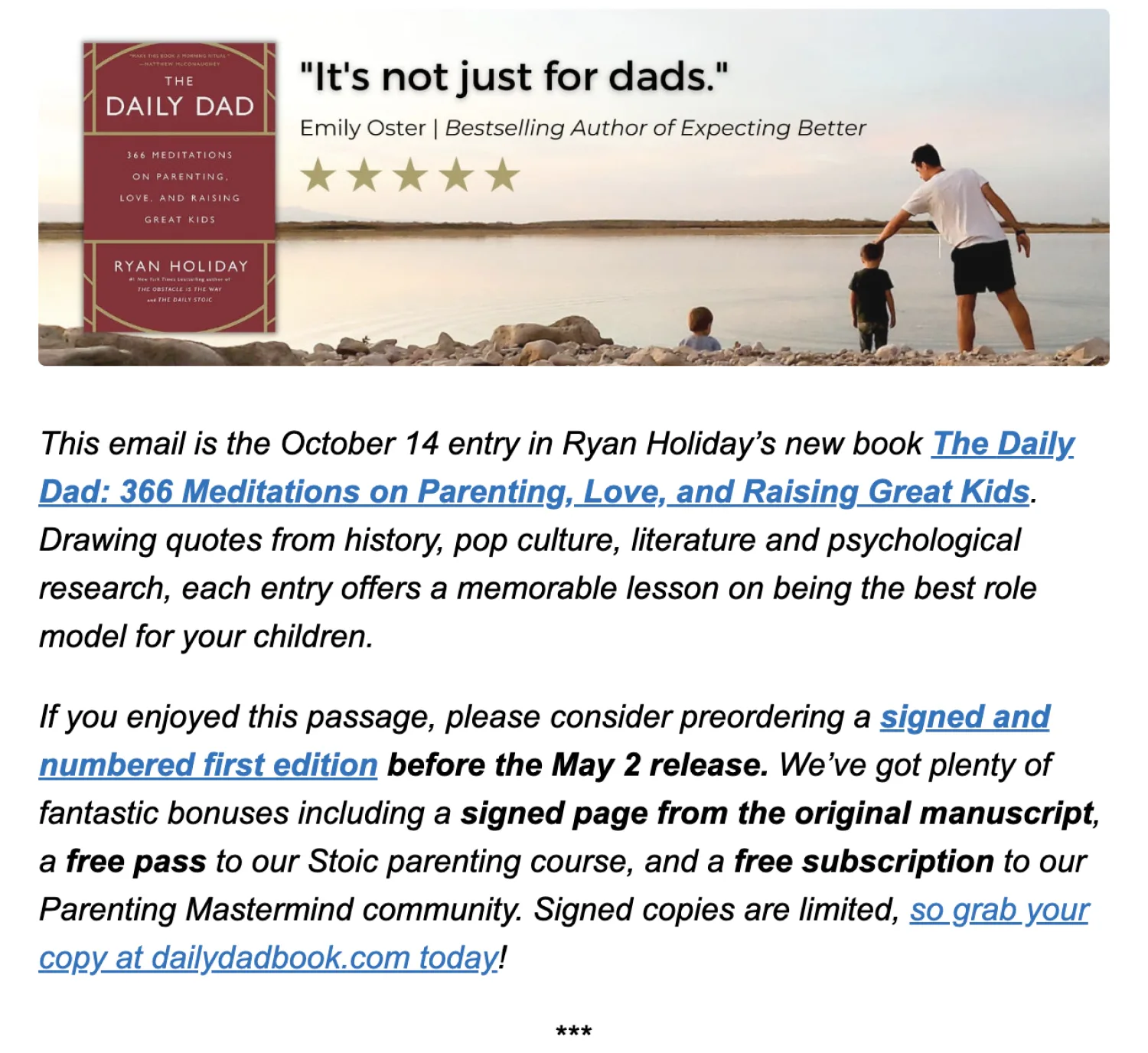
Ryan Holiday includes a book snippet to promote pre-orders
Email #2: Launch day
On launch day, you’re opening the virtual doors to your new product. Your subscribers can finally purchase it—and this email has the task of making them as excited and confident about your product as you are.
More specifically, this email shows the value your new offering will create for people in your audience. The idea is to make lightbulbs go off in their heads as they see the transformation and results that are possible if they go through your course, ebook, membership, or coaching.
And as they picture those potential outcomes and become invested in the chance to learn from you, they’ll keep coming back to this email to review the key points about your product.
In this email, include:
- Personalized introduction, especially for those who interacted with your announcement email
- Detailed product information
- Product visuals, like images or an image gallery, a GIF, or a video
- Social proof from previous customers or your result using the process from your product
- Countdown
- Bonuses or limited-time offers included in the launch
- CTA (consider having multiple; one early in the email and one at the bottom)
- Custom signature with helpful links
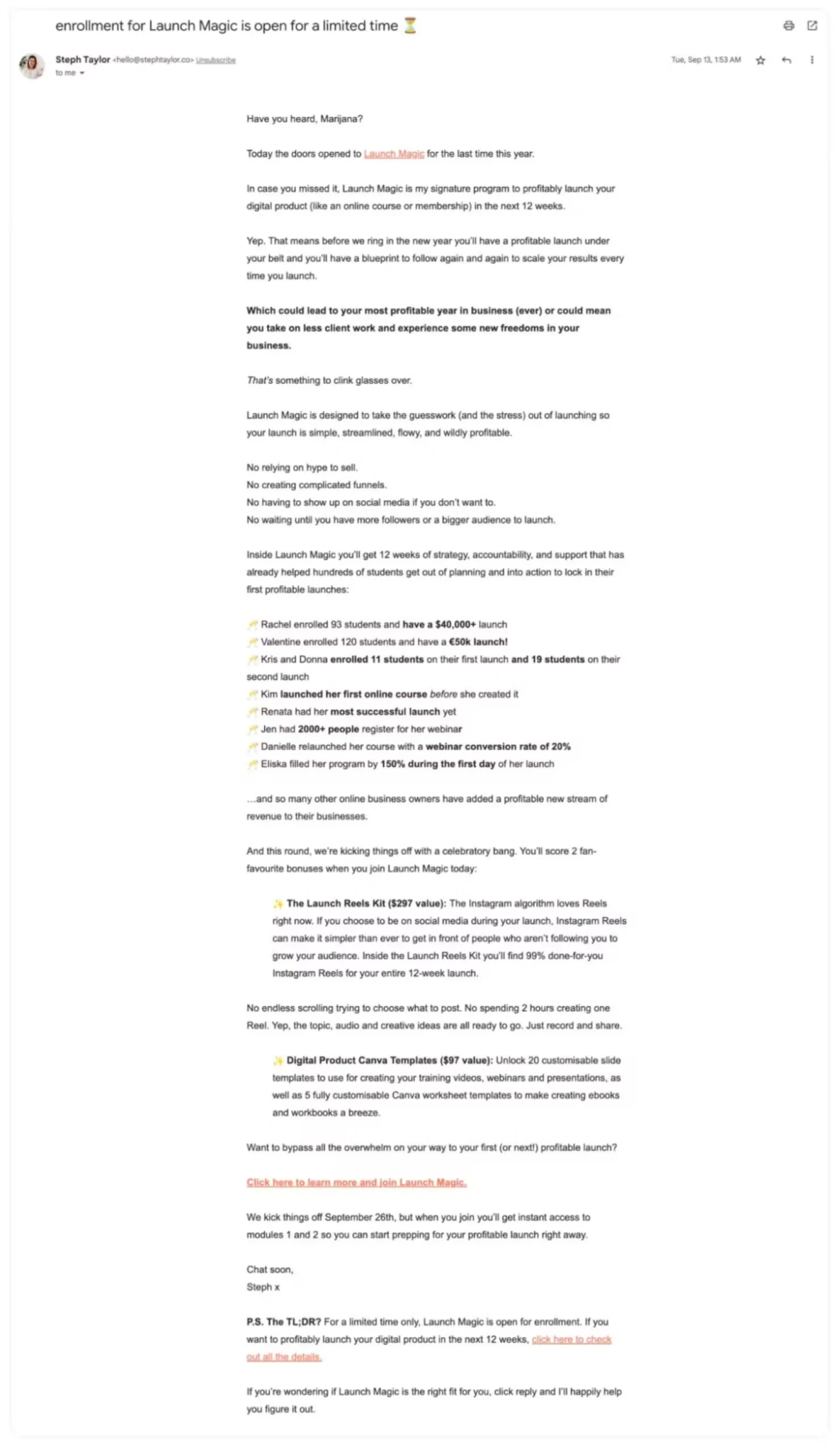
Steph Taylor’s email to announce the cart for her Launch Magic program is open
Email #3: Follow-up
Your subscribers have had time to review your offer—your launch email and sales page. Those who haven’t purchased likely aren’t sure if your product is for people like them, and they have questions about that. These might look like:
- “Will this work for me if…”: I’m a beginner, I’m not tech-savvy, etc.
- “What if I…”: don’t have a business yet, live in [country], etc.
- “I’m worried that…”: I don’t have what it takes, I won’t have enough time, etc.
Chances are, you’ve already addressed these questions on your sales page (as you should).
However, having a dedicated email that only focuses on these perceived limitations and potential objections shows your subscribers that you understand their thought process and care about their experience.
It also opens up a two-way communication channel as they can reply to that specific email and dig into a particular pain point or doubt about your product—and you can personalize your reply and help them feel heard.
This email should include:
- Personalized introduction
- Answers to frequently asked questions, one section per question
- Countdown (consider having one at the top and one at the bottom if the email is long)
- Product visuals, like images or an image gallery, a GIF, or a video
- CTA
- What’s in the product, including bonuses
- Custom signature with helpful links or social proof
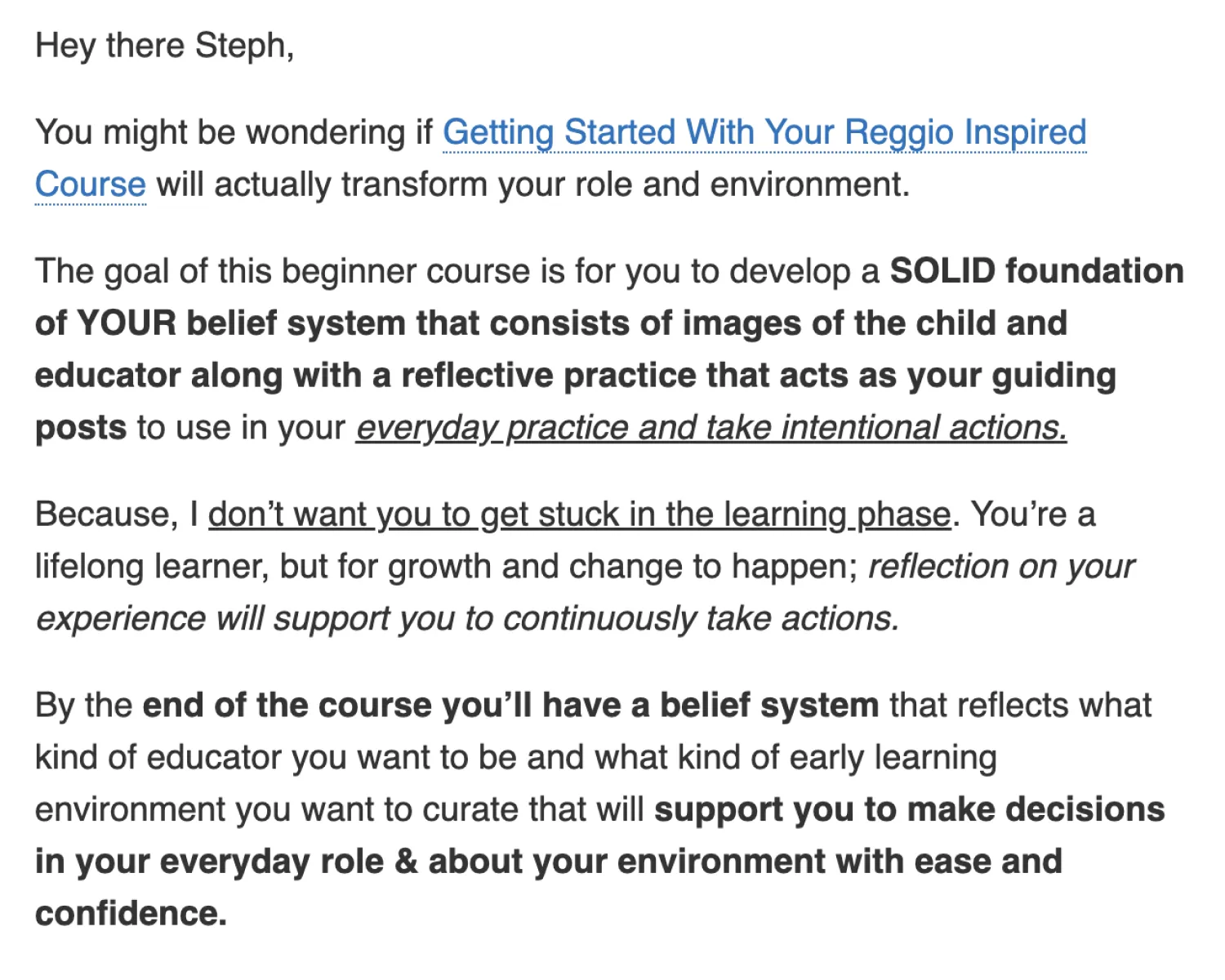
Veronica Green addresses course outcomes in this product launch follow-up message
Email #4: Last chance
Finally, many people will leave their decision to purchase your product until the very last day. Creators often report that most of their sales happen at the tail end of the launch—so don’t be alarmed if you haven’t yet hit your launch goal as this day approaches.
Use the last chance email to paint a vivid picture of the transformation they will experience after going through your product. Show them what’s possible by sharing more social proof and images or videos of the inside of the product.
And crucially, highlight the opportunities that will disappear once the countdown hits zero: discounts, bonuses, or the option to purchase altogether.
Your last chance email needs to have:
- Personalized introduction
- Countdown (one early in the email, one at the bottom)
- What’s in the product, including bonuses
- CTA
- Custom signature with social proof
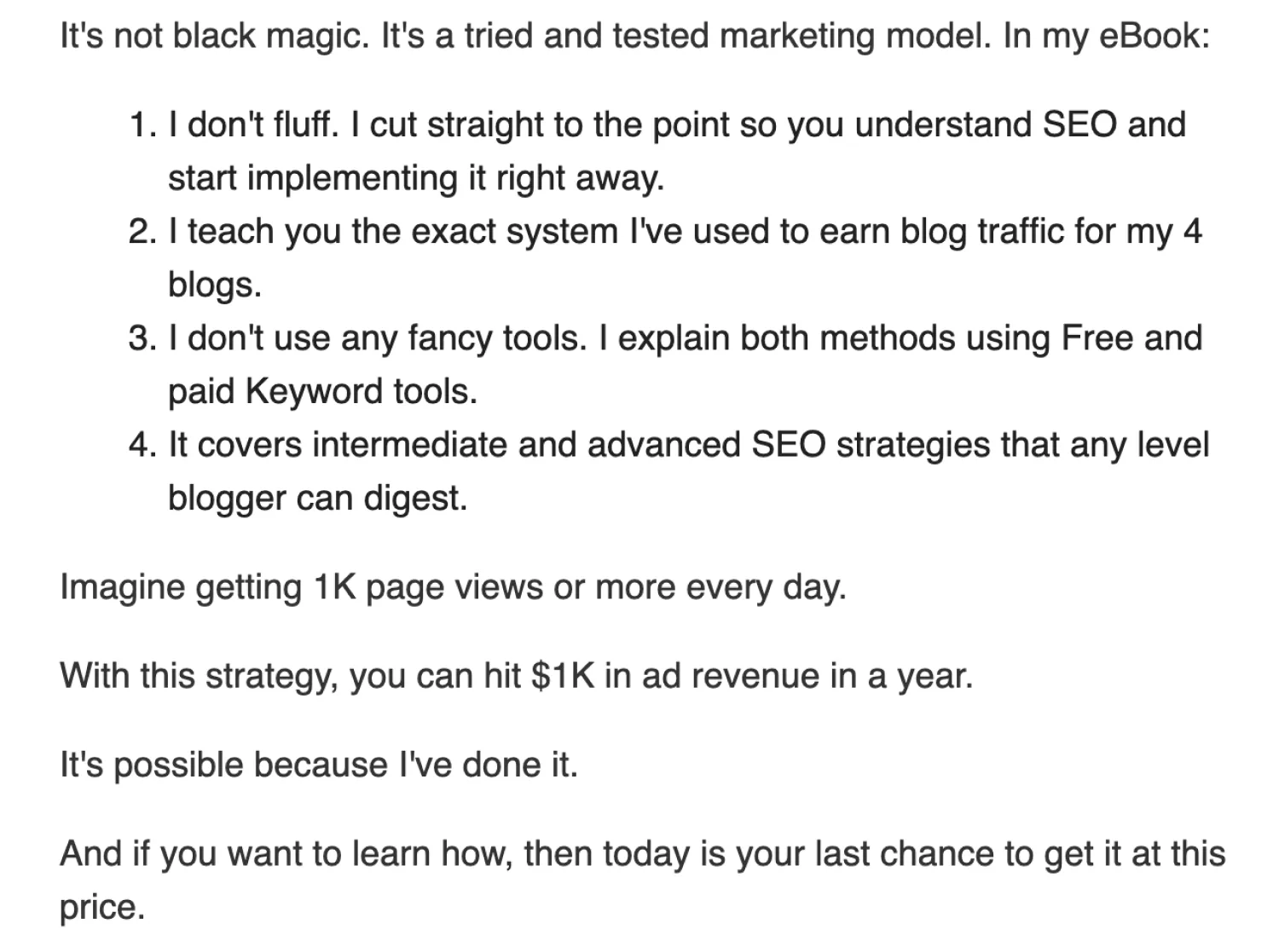
Angela from Stray Curls sends a last chance email before the book price increases
How to automate your product launch email campaign
One of the best aspects of a product launch email campaign is that you can write and perfect it long before launch day and let it do the work for you. After you’ve written your launch emails, here’s a step-by-step guide to using a simple automation with Kit.
- Sign into your Kit account and click on the ‘Automate’ tab
- Click the ‘New Automation’ button or choose a visual automation template
- Choose a starting point for your automation—whether it’s a ‘coming soon’ sign-up page or a customer segment tag
- Select the ‘+’ symbol and choose ‘Date occurs’ under the ‘Event’ category to start your product launch warm-up sequence on a particular date
- Then, add ‘Email sequence’ from the ‘Action’ category and select your warm-up sequence
- Repeat the process to add your launch day email on your launch date
If you want to skip ahead a few steps, copy our book launch email automation template and customize it with your customer tags and email sequences.

Additional tips to improve the effectiveness of your product launch emails
The best way to improve your product launch emails is through experience and experimentation, but there are a few tips to get you started.
Take advantage of tags and segmentation
Instead of mass emailing everyone, you can specify who to send your launch emails to to ensure your ideal customers feel seen, heard, and understood.
Email tags identify subscribers who have a specific trait or took an action, like signing up on a ‘coming soon’ or pre-order landing page. If people sign up to hear about your new launch, you can offer an exclusive discount code to them or give them first dibs on ordering limited quantity items.
Email segmentation, on the other hand, groups people together, like identifying people who purchased a product in the past or expressed interest in the same topic. For example, you could reserve promoting your high-end or one-on-one product to loyal customers instead of brand new subscribers.
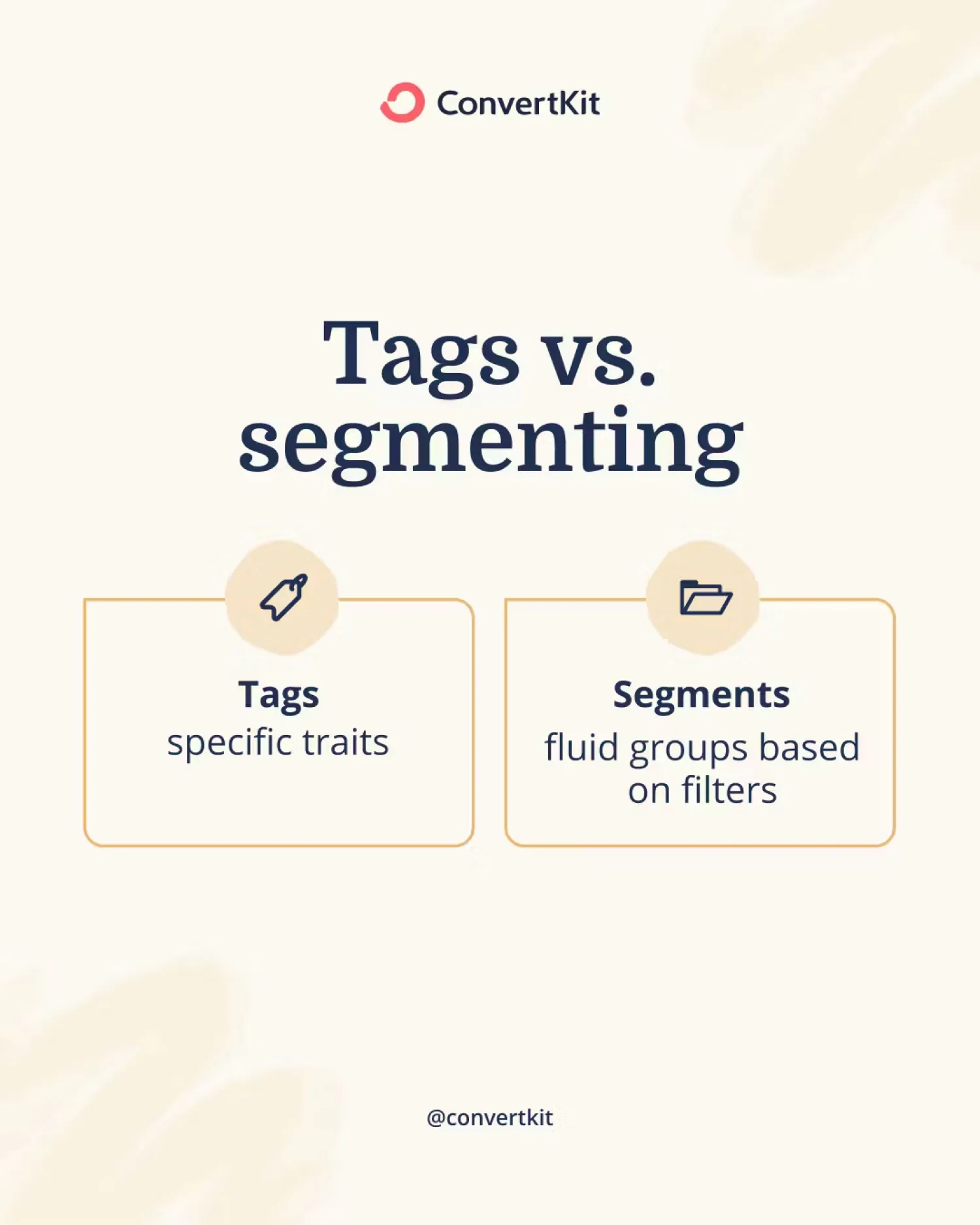
Pro tip: Add a “PS” note at the bottom of your product launch emails with a Link Trigger to give subscribers a chance to opt out of your marketing flywheel. This ensures you don’t lose subscribers just because they aren’t a right fit for your current product.
Keep an eye on your product launch numbers
The email marketing metrics that matter during launch depend on your goals. For example, if revenue is your priority, pay attention to sales page conversion rates. If this product launch tests interest in a new topic, compare open and click-through rates to past launches.
Here are the product launch numbers you can measure:
- Open rates gauge how relevant and compelling your email subject line, topic, and product name are
- Click-through rates let you know if your sales copy and CTA buttons made subscribers want to learn more about your product
- Conversion rates reveal whether your sales page made people want to buy your product
- Unsubscribe rates indicate that subscribers didn’t like the content you sent or aren’t part of your target audience anymore
Nurture customers who purchase
After weaving your product offers into each product launch email, you’ll start to see customers roll in. When they purchase your product, you can tag them as a customer with “Customer: Product Name” to put them on a different path than subscribers who haven’t purchased yet.
Then, you can follow up with an email that thanks them for their purchase and checks in on their progress after a week or more. For future launches, you could even offer these customers early access, the chance to beta test a product, or a discount.
Consider a downsell for those who don’t buy
Although some subscribers may not be ready to buy your initial product, they may buy a similar product at a more affordable cost. This is where a downsell comes in—a message to buy a related, but cheaper, product. Only offer this downsell to people who haven’t purchased your product.
It’s smart to downsell a product that teaches on a similar topic with just enough information to lead the customer into the next round of your original product. This helps you create lifetime customers who continue to grow with you.
Build your rinse-and-repeat launch emails
Yes, every launch will create a mix of feelings and challenges. But with the right tools and templates on your side, you can help your products reach the right people and help them see meaningful results—all while you’re enjoying the process and hitting your launch goals.
Sign up with Kit and start automating your next product launch.
